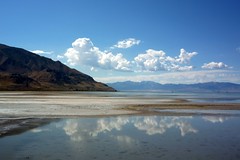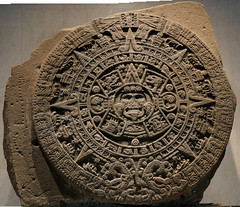These were our notes from over the summer.
| This ancient salt-water lake was huge. It covered present day Utah, Nevada, and Idaho. Drained out slowly over time. The Great Salt Lake in Utah is all that remains of it. |  | |
| The population of the New World in 1492 | ||
| 3 highly sophisticated South American civilizations. Specifically from Peru, Central America, and Mexico (in that order). |  | |
| The major crop which the Incan, Mayan, and Aztec civilizations cultivated and were build upon. |  | |
| Crop that transformed nomadic tribes into settled agricultural villages. |  | |
| The population of North America in 1492 | ||
| These series of religious wars during the Middle Ages whetted the European appetite for exotic SPICES and foreign goods (silk, drugs, perfume, textiles) |  | |
| Rounded Africa and reaches India in 1498, returns home with tantalizing cargo of jewels and spices. |  | |
| One of the 3 highly sophisticated South American civilizations. From Peru |  | |
| One of the 3 highly sophisticated South American civilizations. From Central America |  | |
| One of the 3 highly sophisticated South American civilizations. From Mexico |  | |
| Closest thing to a nation state in North America | ||
| 1295, returns from 20 years in China. Italian. Imprisoned for a time because no one believed his stories. | ||
| Persuaded the new monarchs of newly united Spain, Ferdinand and Isabella, to finance his expedition to the New World. | ||
| Better, faster, more efficient ship invented by the Portuguese. Opened up the markets of sub-Saharan Africa to trade with Europe. | ||
| Gold-rich kingdom in West Africa. Traded with the Portuguese | ||
| Intertwined the economies of Europe, Africa, and the Americas. Europe provided the markets, capital, and technology; Africa the slaves for manuel labor; and the Americas the raw materials such as precious metals and soil for sugar plantation | ||
| tobacco, maize (corn), beans, tomatoes, potatoes. iguana, syphillis | ||
| cattle, horse, swine, SUGAR, smallpox, yellow fever, malaria | ||
| 1494. Divided the New World between Spain and Portugal. Portugal got Brazil and territory in Africa and Asia, Spain got the rest. | ||
| Discovered Pacific Ocean in 1513 | ||
| First circumnavigation of the globe | ||
| Explores Florida in 1513 and 1521 | ||
| Explores Arizona and New Mexico | ||
| First European to cross the Mississippi | ||
| Crushes the Incas in Peru in 1532. Finds the silver mines of Potosi in modern Bolivia. | ||
| Mineral from the mines of Potosi and others. Dramatically increased European money supply. Birth and growth of capitalism. Inflation | ||
| (Spanish for "to give") Basically slavery. Government agrees to give colonists Indian slaves if they promise to Christenize them. | ||
| Spanish conquistador (conquerer). In 1519, sailed 11 ships from Cuba to Mexico, picked up a Spanish captive and takes female Indian slave Malinche (used both as interpreters). Lays seige to Aztec capital of Tenochtitlan. Conquest, conquers. Ultimately, a small pox epidemic destroys the remaining Aztec Empire | ||
| Aztec Chieftan when Cortez attacks. At first welcomes the Spanish. Very superstitious, believed Cortes was the ancient god Quetzalcoatl | ||
| Amazing Aztec metropolis with a population of over 3,000. Situated in the middle of a lake surrounded by system of floating gardens, causeways, and aqueducts. Mexico City built upon its ruins. | ||
| Name of race of people of mixed Indian and European heritage, particularly from Mexico | ||
| Columbus Day in Mexico. "Day of the Race" in Spanish. Celebrates the birth of a new distinct race of people. | ||
| English explorer that explored Northeastern America. | ||
| Explorer sent by the French to explore the American East coast | ||
| Explorer who travelled up St. Lawrence River | ||
| Indian rebellion in 1680 against Spanish priests that demolished churches and built Kivas (Native-American ceremonial religious temples) on their ruins | ||
| Explorer who travelled up the California coast in 1542 | ||
| Spanish, Franciscan priest who founded 21 missions up the California coast as far north as San Francisco | ||
| Native American tribe from the Southwest that formed agricultural villages and towns (hint: spanish word for town!) founded on the cultivation of maize. | ||
| Socio-cultural movement in 1400's Europe that stimulated global curiosity and the Age of Exploration | ||
| Massive geological shield that covers Canada and parts of Northern United States covered by a thin layer of soil. | ||
| Prehistoric tribe in North America that built mounds for ceremonial, religious, burial, and residential purposes. | ||
| "Invinceable" naval fleet that fought, and lost, against the English Navy in 1588 | ||
| Nickname for the Spanish conquerers provoked by fear of their cruelty, intolerance, and fanatiscism | ||
| Spanish "conquerors" (soldiers, explorers, and adventurers) that invaded and conquered South American civilations from the 15th to the 19th centuries | ||
| 1 | ||
| 1 | ||
| 1 | ||
| 1 | ||
| 1 | ||
| 1 | ||
| 1 | ||
| 1 | ||
| 1 | ||
| 1 | ||
| 1 | ||
| 1 | ||
| 1 |

